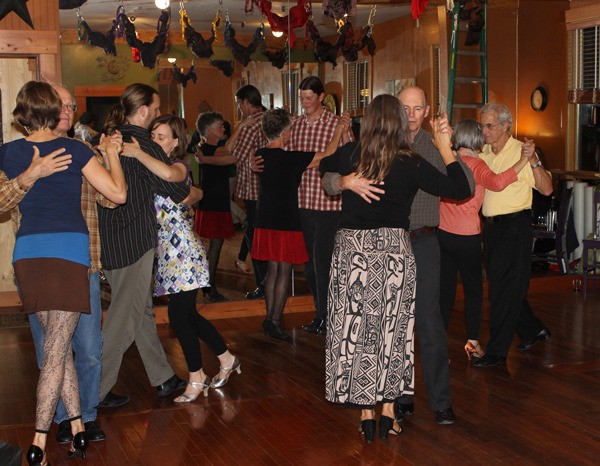A stanza of rich and vital music ascends from the speakers, breaking the evening silence at Bayview Corner; four couples silently take to the studio floor, keeping time with one another’s precise steps and slight sways as if attuned to the notes as by one another’s energy.
The dancers are students of Sojourn Studio’s Argentine tango course led by instructor David Imbergia who has been mastering the “dance of connection” since 2001.
“I enjoy tango specifically because of its very unique flavor, personality and ability to spiritually connect with the partner,” said Imbergia. “Tango is called the dance of connection… everybody likes to feel connected.”
Each Tuesday evening at 6:30 p.m., a group of about 20-30 beginning, intermediate and advanced students of a variety of professions, ages and backgrounds make their way to the studio for an opportunity to learn, relax and rejuvenate.
The night begins with beginning and intermediate dancers and ends with a mingling of primarily intermediate and advanced students.
Sari Spieler, Freeland resident and owner of Whidbey Healing Arts, has been attending weekly classes at Sojourn Studios with her husband, Daniel Goldsmith, since the class began three years ago. The couple uses the class as an opportunity to wind down and reconnect.
Spieler, who holds a degree in dance therapy, is well attuned to the correlation between motion, music and healing.
During the day, Spieler works in many capacities, including elder advocate, power of attorney for healthcare, certified professional guardian for vulnerable adults and massage therapist. As a part of her work, which often includes a 6 a.m. to 6 p.m. day, she accompanies clients to court and medical appointments and assists them in navigating difficult situations.
“It’s the break in the middle of the crazy,” she said. “I always make sure we stop at the class and dance for a couple of hours before we go back to work, so it is a balance point in my day quite often.”
Since its inception in the late 19th century in the working-class suburbs of Buenos Aires, Argentina, tango has offered dancers respite and an expressive outlet. The dance was developed as a combination of forms including Cuban habañera, milonga and African candombe. Due in part to the quality of the music, according to Imbergia, tango acted as a bridge between classes, an unusual dance in its appeal to classes rich and poor.
Because most of the immigrant population of Buenos Aires were men, it was typical for men to dance the tango together. Today, it is more common for men to dance as “leaders” while women dance as “followers.”
However, as Imbergia noted during a class Tuesday, Oct. 14, it is really more of an exercise in teamwork.
Throughout the class, Imbergia demonstrated the ways in which subtle movements and fixtures of posture could convey a “paragraph of meaning” to a partner and explained the ways in which certain steps and principles may prove more difficult for followers while others are more difficult for leaders, to whom the follower must entrust their confidence.
“Most of the time it has got a mixture of pressure and excitement, especially if you are dancing with a leader who is playful and inventive and creative who forces you to stay present and spontaneous,” said Spieler.
Spieler said she has been dancing “since the day I was born” and recalled that she and her husband met at a non-alcoholic dance event in Seattle nearly 25 years ago. Though the couple tried several other dances, including a variety of different Latin and ballroom disciplines, they could not seem to find a happy medium, a way to dance together.
In part due to Spieler’s prior lack of experience with tango, she said, the dance finally provided a level playing field for the more experienced Spieler and her husband who, although not necessarily an advanced dancer, shared her joy in the art form.
She explained that, in contrast to other dances, tango forces the person to slow down and connect with their partner.
“I don’t know if there are other dances that encourage or allow that to happen,” said Spieler.
Although some spouses may find the idea of watching their partner in a close embrace with another person nervewracking, Spieler said quite the opposite is true for her and Goldsmith. She also pointed out that, despite misconceptions, the connection of the tango is non-sexual and may more accurately be described as spiritual or emotional.
“We enjoy watching the other dance with other people because we know how much fun they are having,” she said. “There is no sense of jealousy or competitiveness.”
Terra Anderson and her husband, Tom Buxton, share Spieler’s sentiment. The couple has been attending the classes for a little over a year.
Anderson noted that she has danced several other forms, including ballroom, but tango has proven to be a favorite for both her and Buxton.
Beginning at 5 p.m. Friday Nov. 7 through Sunday, Nov. 9, Sojourn Studios students and other area tango enthusiasts will be convening in Coupeville for the second annual Whidbey Island Tango Festival. The festival includes classes for all skill levels, milangas, vendors and more. According to Imbergia, 200 or more dancers are expected to attend. Cost for each event varies, with most ranging from $10-20 per class. Full festival passes are $165. Visit wta.storenvy.com to register and for more information about the festival.



